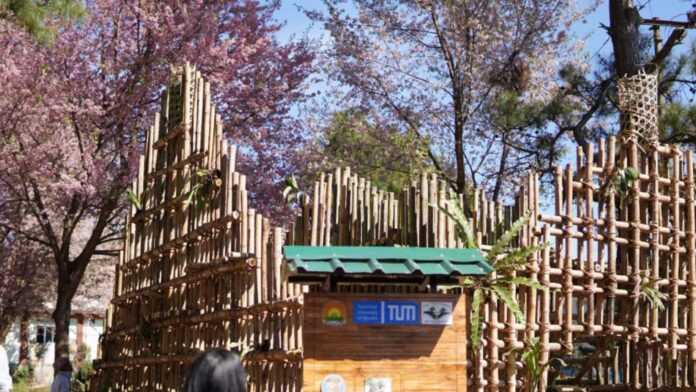Staff reporter:
The intricate bamboo structure close to the lake on the campus of the North Eastern Hill University, with a few Cherry Blossom trees for colourful company stands out, arousing the curiosity of the uninitiated.
Come some years, the structure will no longer be there, and in its place will be one of Meghalaya’s signature of pride, the living root bridge, far removed from its otherwise rural and remote origin.
Living root bridges are an integral part of the cultural and traditional heritage of Meghalaya. The bridges are symbolic of the intimate relationship of the tribals with nature. Ficus Elastica is the tree that is used as it can grow aerial roots. To build a similar structure as a tribute to the heritage associated with the tribes of the state, the North Eastern Hill University in collaboration with the Living Root Bridge Foundation and Technical University of Munich has conceptualised a bamboo structure that will serve as the support system for the roots to grow.
The project was taken up by all the stakeholders in an online joint studio exercise, which had students from TU Munich and the Department of Architecture, NEHU working together in groups. It was conceptualised over a period of a semester of around six months.
Ibynta Tiewsoh, Assistant Professor, Department of Architecture said, “The living root bridges are very much a naturally-built heritage that we the people of Meghalaya identify with. Architecture has always had a deep connection with nature for inspiration and understanding the environment that we inhabit. This research project is a way for us to look at living architecture in an urban setting, and how it fits into the context of building along with nature. It made sense to us to investigate bamboo as a building material and how this helps in supporting life processes.”
The root bridges are part of the naturally-built ecosystem and are believed to have persisted for hundreds of years.
“It is well described as a natural cultural heritage, there’s a lot of embedment of culture here in natural things. A lot of music comes from plants that are grown here, lots of traditional hunting techniques are embedded in local specific things. So we have this bamboo pavilion on which these Ficus (Also known as Indian Rubber Fig) roots will grow and we guide the these down the structure, and it grows over time, and eventually everything will be replaced with the root structure,” mentioned Wilfrid Middleton, Researcher, Technical University of Munich.
This project had participation of the Khasis, Jaintias and Garos and hence was not owned by any tribe in specific. The Living Bridge Foundation has played a major part in bringing this concept to life.
Morning Star Khongthaw and Shining Star Khongthaw are the founding members of the Living Bridge Foundation.
Morning Star said, “This idea was born a few years back, but could not be turned into reality because of the pandemic. The TUM team along with NEHU were planning to design something with the roots of the Ficus tree as part of something that they can learn from the Khasi-Jaintia community. This project has brought members from the entire state united and what can be better than that?”
Unto the technical aspects of the bridge and about how the bamboo was treated,
Tiewsoh mentioned, “The first important part was to treat the bamboo. This is done by smoke treatment, which reduces the moisture content. The soil was dug to a depth of two feet, and then stone soling was laid first. After that the vertical bamboo members were fixed on the ground using concrete (cement, sand and aggregate), to keep away termites.”
Justifying Build, Design and Grow, the first step that was the ‘build’ of the project has just concluded which saw the participation of the fourth year students, and they received hands-on training on working with bamboo as a construction material.
The Living Bridge Foundation helped in guiding everyone to what needs to be done, and will be helping in the research project by monitoring the growth of the Ficus seedlings every year.
The last part, ‘grow,’ will require a lot of nurturing and observation over a period of at least 10 years before some considerable changes are visible. The collaboration has been a testimony for the students on how to approach sustainable design and building.


